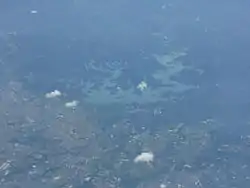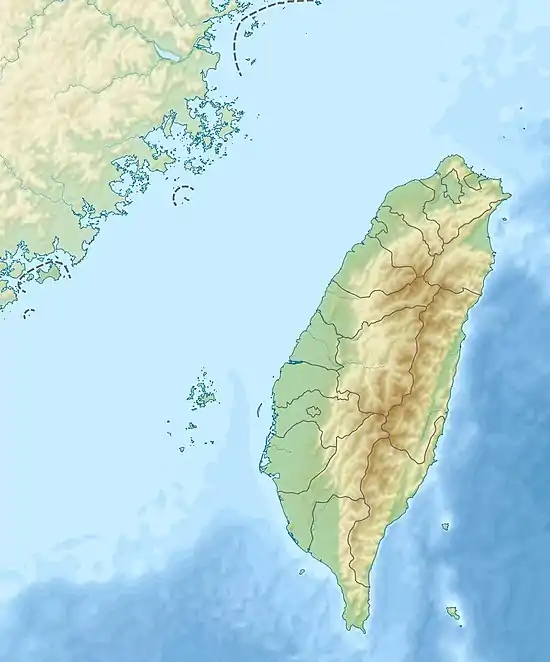| Wushantou Reservoir 烏山頭水庫 | |
|---|---|
 | |
 Location of Wushantou Reservoir 烏山頭水庫 in Taiwan | |
| Country | Taiwan |
| Location | Lioujia, Guantian Districts, Tainan |
| Coordinates | 23°12′20.5″N 120°23′24.88″E / 23.205694°N 120.3902444°E |
| Status | In use |
| Construction began | 1920 |
| Opening date | 1930 |
| Dam and spillways | |
| Type of dam | Embankment Dam |
| Impounds | Guantian Creek, Zengwun River (by tunnel) |
| Height | 56 m (184 ft) |
| Length | 1,273 m (4,177 ft) |
| Spillways | Guantian Creek |
| Spillway type | Gated overflow, service |
| Spillway capacity | 1,500 m3/s (53,000 cu ft/s) |
| Reservoir | |
| Creates | Wusanto Reservoir |
| Total capacity | 154,158,000 m3 (5.4440×109 cu ft) |
| Catchment area | 58 km2 (22 sq mi) |
| Surface area | 13 km2 (3,200 acres) |
| Power Station | |
| Installed capacity | 50 MW |
| Annual generation | 438,000 KWh |
Wushantou Reservoir (Chinese: 烏山頭水庫; pinyin: Wūshāntóu Shuǐkù), sometimes spelled Wushanto or Wusanto, is a reservoir and scenic area located in Lioujia District and Guantian District of Tainan, Taiwan. It is also referred to as Coral Lake (珊瑚潭; Shānhútán) due to its zigzagging shoreline. The reservoir was designed by engineer Yoichi Hatta and was the largest in Asia at the time of its completion in 1930.[1]
Overview
Construction of the Wusanto Reservoir began in 1920 and was completed in 1930. The goal of the project was to provide irrigation for over 100-thousand hectares of farmland in the Chianan area.[2] After construction of the reservoir, the irrigation plain became an important producer of rice for consumption in Taiwan and Japan, with three rice harvests possible each year.[3]
Engineering
The reservoir was built in conjunction with the Chianan Canal, also designed by Hatta.[2] At the time of its completion, Wusanto Reservoir was the largest reservoir in Asia and the third largest in the world.[1] Construction of the reservoir and of the Wusanto Dam used an uncommon semi-hydraulic fill technique, where fine-grained material is placed at the end of an embankment and then washed into its desired position using jets of water; this is a variant of the hydraulic fill technique.[4] Wusanto Reservoir is the only project constructed with the semi-hydraulic fill technique that is still in use anywhere in the world. This process was expensive and time-consuming, but produced a dam which has proven resistant to Taiwan's severe seismic activity.[3]
Scenic area
Today, the Wusanto Reservoir Scenic Area is a popular tourist destination in Tainan. The area includes a memorial and museum for Yoichi Hatta. Cherry blossom viewing is a popular event in spring. The area is also known for its abundant native flora and fauna.[5]
See also
References
- 1 2 Yang, S.D. "Hatta, Yoichi". Retrieved 18 November 2013.
- 1 2 "Potential World Heritage Sites in Taiwan: Wushantou Reservoir and Jianan Irrigation Waterways". Bureau of Cultural Heritage, Ministry of Culture. Retrieved 18 November 2013.
- 1 2 Liu, Alexandra. "Country Travel, New Style". Retrieved 18 November 2013.
- ↑ Graham, Andrew. "World Wide Web Pages for Dam Design". Retrieved 18 November 2013.
- ↑ "Wusanto Reservoir Scenic Area (Coral Lake)". Retrieved 18 November 2013.